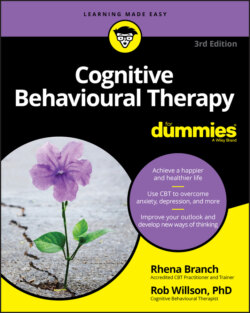Читать книгу Cognitive Behavioural Therapy For Dummies - Rob Willson - Страница 20
Learning Your ABCs
ОглавлениеWhen you start to get an understanding of your emotional difficulties, CBT encourages you to break down a specific problem you have using the ABC format, in which
A is the activating event. An activating event means a real external event that has occurred, a future event that you anticipate occurring or an internal event in your mind, such as an image, memory or dream. The A is often referred to as your ‘trigger’.
B is your beliefs. Your beliefs include your thoughts, your personal rules, the demands you make (on yourself, the world and other people) and the meanings that you attach to external and internal events.
C is the consequences. Consequences include your emotions, behaviours and physical sensations that accompany different emotions.
Figure 1-1 shows the ABC parts of a problem in picture form.
© John Wiley & Sons, Inc.
FIGURE 1-1: A is the activating event, B is your beliefs and thoughts and C is the consequences, such as the emotions you feel after the event and your subsequent behaviour.
Writing down your problem in ABC form – a central CBT technique – helps you differentiate among your thoughts, feelings and behaviours and the trigger event. We give more information about the ABC form in Chapter 3, and you can find a blank ABC form in Appendix B.
Consider the ABC formulations of two common emotional problems, anxiety and depression. The ABC of anxiety may look like this:
A: You imagine failing a job interview.
B: You believe, ‘I’ve got to make sure that I don’t mess up this interview; otherwise, I’ll prove that I’m a failure’.
C: You experience anxiety (emotion), butterflies in your stomach (physical sensation), and drinking to calm your nerves (behaviour).
The ABC of depression may look like this:
A: You fail a job interview.
B: You believe, ‘I should’ve done better. This means that I’m a failure’!
C: You experience depression (emotion), loss of appetite (physical sensation), and staying in bed and avoiding the outside world and drinking to quell your depressed feelings (behaviour).
You can use these examples to guide you when you are filling in an ABC form on your own problems. Doing so will help ensure that you record the actual facts of the event under ‘A’, your thoughts about the event under ‘B’, and how you feel and act under ‘C’. Developing a really clear ABC of your problem can make it much easier for you to realise how your thoughts at ‘B’ lead to your emotional/behavioural responses at ‘C’. (Chapter 3 describes the ABC form more fully.)
